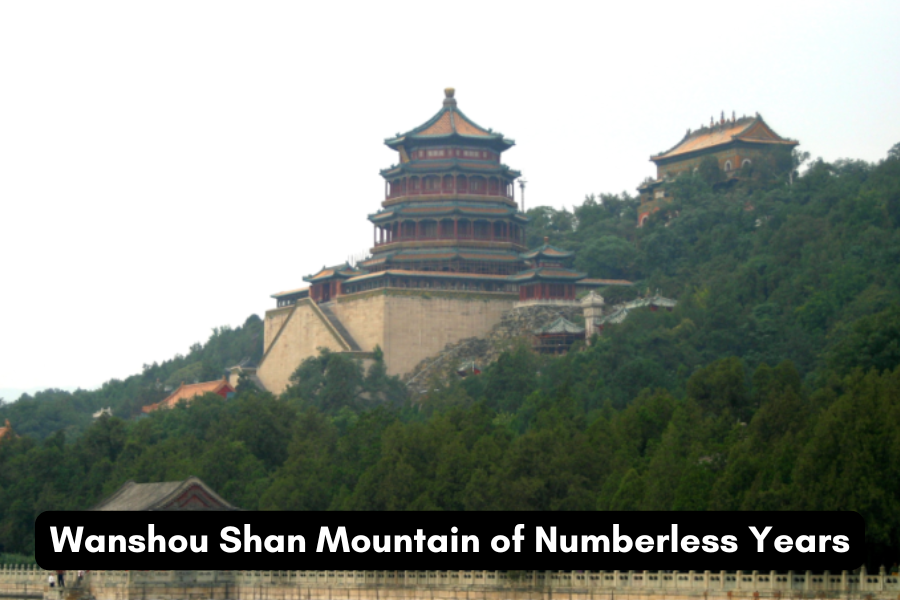
Wanshou Shan Mountain of Numberless Years
When reflecting on China’s most important cultural and historical landmarks, the Wanshou Shan Mountain of Numberless Years stands out with its significant place in history. Situated within the vast grounds of the Summer Palace in Beijing, Wanshou Shan represents a remarkable fusion of art, architecture, and nature, showcasing the deep-rooted traditions of imperial China. The mountain’s rich historical legacy, striking architectural feats, and tranquil natural beauty make it one of the most revered landmarks in Chinese history.
Wiki
| Feature | Details |
| Name | Wanshou Shan Mountain of Numberless Years |
| Location | Summer Palace, Beijing, China |
| Other Names | Longevity Hill |
| Historical Significance | Symbol of longevity, prosperity, and imperial power during the Qing Dynasty |
| Established | Originally in the Jin Dynasty; major reconstruction during the Qing Dynasty under Emperor Qianlong |
| Architectural Highlights | Tower of Buddhist Incense (Fo Xiang Ge), Hall of Dispelling Clouds (Paiyun Dian), Hall of the Sea of Wisdom (Zhihui Hai) |
| Notable Features | Tower, pagodas, Buddhist sculptures, gardens, Kunming Lake |
| UNESCO World Heritage | Yes, as part of the Summer Palace (1998) |
| Main Symbolism | Longevity, prosperity, spiritual harmony |
| Best Time to Visit | Spring and Autumn for mild weather and scenic beauty |
| Cultural Influence | Inspiration for Chinese poets, artists, and scholars |
| Current Use | Major tourist destination and historical site |
| Famous Emperor | Emperor Qianlong (reconstruction and symbolic importance) |
The Historical Beginnings of Wanshou Shan Mountain of Numberless Years
The roots of Wanshou Shan Mountain of Numberless Years can be traced back to the Jin Dynasty (1115–1234), when it was originally called the Gold Mountain. Its scenic allure and strategic location made it a place of great interest for early Chinese rulers, who sought to preserve and develop its landscape. Over the centuries, Wanshou Shan was significantly modified, evolving in both form and function.
During the Yuan Dynasty (1271–1368), the hill was renamed Jar Hill and became part of the imperial landscape. However, it was during the Qing Dynasty (1644–1912) that Wanshou Shan Mountain of Numberless Years truly gained its iconic status. Emperor Qianlong, one of the most celebrated rulers of the Qing era, oversaw an extensive reconstruction of the hill to commemorate his mother’s 60th birthday. This restoration solidified Wanshou Shan’s place as a central feature of the Summer Palace, symbolizing longevity and imperial splendor.
The Symbolic Meaning Behind Wanshou Shan Mountain of Numberless Years
Wanshou Shan Mountain of Numberless Years carries deep symbolism, with its name translating to “Longevity Hill,” reflecting the emperor’s wishes for lasting prosperity and peace. It was not merely a place for leisure but also embodied the cultural ideals of imperial China.
The hill’s design, along with the structures that crown it, draws heavily from ancient Chinese philosophies like Daoism and Buddhism. These teachings focus on the harmonious relationship between humans and nature, which is beautifully mirrored in the way Wanshou Shan is seamlessly integrated into its natural surroundings. The layout follows the principles of Feng Shui, which strives to balance the energy in the environment and create a peaceful atmosphere.
Architectural Wonders of Wanshou Shan Mountain of Numberless Years
Wanshou Shan Mountain of Numberless Years is home to some of the Qing Dynasty’s most remarkable architectural achievements. Every structure on the mountain has a specific purpose and contributes to the grandeur of the site.
The Tower of Buddhist Incense
One of the most prominent structures atop Wanshou Shan Mountain of Numberless Years is the Tower of Buddhist Incense (Fo Xiang Ge). This three-story tower, standing at 41 meters, dominates the skyline and was built as a place of worship. The tower houses intricate Buddhist artifacts, including statues and carvings, that reflect the spiritual beliefs held by the Qing rulers.
In addition to its religious significance, the tower offers stunning views of Kunming Lake and the surrounding gardens. Its vibrant colors, detailed carvings, and elaborate designs stand as a testament to the artistic mastery of the period.
The Hall of Dispelling Clouds
Midway up the hill sits the Hall of Dispelling Clouds (Paiyun Dian), a grand structure designed to host imperial events and ceremonies. It served as a venue for emperors to entertain guests, host dignitaries, and display the grandeur of the Qing court.
The hall is known for its opulent decor, including gold-painted ceilings, detailed murals, and fine wood carvings. The lavishness of the Hall of Dispelling Clouds showcases the wealth and authority of the Chinese emperors.
The Hall of the Sea of Wisdom
At the summit of the hill stands the Hall of the Sea of Wisdom (Zhihui Hai), a hall renowned for its unique design. Its walls are adorned with thousands of small Buddha statues, each a work of art in itself, representing the rich Buddhist heritage of the Qing Dynasty.
The hall is also distinguished by the use of colored glaze tiles in shades of blue and green, which create a striking effect by reflecting light in a way that gives the building an almost ethereal glow.
The Natural Beauty Surrounding Wanshou Shan Mountain of Numberless Years
The architectural magnificence of Wanshou Shan Mountain of Numberless Years is complemented by the surrounding natural beauty. The hill is part of the expansive Summer Palace, which spans more than 700 acres and features Kunming Lake, winding paths, and meticulously landscaped gardens.
Kunming Lake, located at the foot of Wanshou Shan, enhances the tranquil ambiance of the area. This man-made lake, which was initially created during the Yuan Dynasty and expanded during the Qing Dynasty, was designed to mirror the famous West Lake in Hangzhou. Today, it serves as a scenic backdrop to Wanshou Shan, perfectly reflecting its beauty on the still waters.
The changing seasons bring new life to the landscape around Wanshou Shan. Ancient trees, blossoming flowers, and meticulously designed gardens make each visit to the hill a unique experience. Whether adorned with spring blossoms, lush summer greenery, vibrant autumn colors, or peaceful winter snow, Wanshou Shan Mountain of Numberless Years offers an ever-changing, breathtaking natural setting throughout the year.
The Cultural and Historical Significance of Wanshou Shan Mountain of Numberless Years
Wanshou Shan Mountain of Numberless Years is much more than a scenic landmark; it embodies the cultural and imperial heritage of China. Throughout history, this hill has been a retreat for emperors, a site for religious activities, and a muse for artists and poets alike.
Imperial Role of Wanshou Shan Mountain of Numberless Years
During the Qing Dynasty, Wanshou Shan Mountain of Numberless Years was an essential component of the Summer Palace, offering the royal family a peaceful retreat from the pressures of court life. The serene surroundings of the hill allowed emperors to meditate, compose poetry, or simply immerse themselves in the beauty of nature, away from the demands of governance.
Artistic Inspiration from Wanshou Shan Mountain of Numberless Years
The awe-inspiring landscapes and grand architecture of Wanshou Shan Mountain of Numberless Years have been a source of inspiration for numerous artists. Ancient poets penned verses celebrating its natural beauty, while painters immortalized its essence with delicate brushstrokes. Even in modern times, the hill continues to serve as a muse for photographers and artists, offering a wealth of creative inspiration.
Spiritual Importance of Wanshou Shan Mountain of Numberless Years
The spiritual dimension of Wanshou Shan Mountain of Numberless Years is reflected in its Buddhist elements, which mirror the religious leanings of the Qing emperors. The Tower of Buddhist Incense and the Hall of the Sea of Wisdom are not just architectural masterpieces; they are also significant places of worship and meditation. These sites attracted Buddhist monks and scholars, providing spaces for prayer and reflection.
Efforts to Preserve Wanshou Shan Mountain of Numberless Years
In the contemporary era, Wanshou Shan Mountain of Numberless Years has been recognized as a valuable cultural asset. As part of the Summer Palace, it was inscribed as a UNESCO World Heritage site in 1998, underscoring the need to preserve it as a key symbol of China’s rich historical and architectural legacy.
The Chinese government has made concerted efforts to restore and protect the hill and its surrounding structures. These initiatives include repairs to aging buildings, the conservation of historical artifacts, and measures to maintain the surrounding natural environment. Visitors to Wanshou Shan today can experience the hill’s beauty much as it was during the Qing Dynasty, thanks to these preservation efforts.
The Visitor Experience at Wanshou Shan Mountain of Numberless Years
Wanshou Shan Mountain of Numberless Years draws millions of visitors from across the globe each year. Its rich history, architectural grandeur, and stunning natural landscapes make it a top destination for anyone exploring Beijing.
Visitors can take a journey along the winding paths of the hill, stopping at notable landmarks such as the Tower of Buddhist Incense. From here, they can enjoy panoramic views of the Summer Palace and Kunming Lake. Guided tours further enrich the experience by providing fascinating insights into the history and symbolism embedded in Wanshou Shan.
Key Facts about Wanshou Shan Mountain of Numberless Years:
- Historical Significance:
Wanshou Shan Mountain of Numberless Years, located within the Summer Palace in Beijing, is a symbol of imperial China’s heritage, representing longevity and prosperity. It has been a retreat for emperors and a source of inspiration for poets and artists for centuries.
- Architectural Marvels:
The mountain is home to several iconic structures, such as the Tower of Buddhist Incense, The Hall of Dispelling Clouds, and The Hall of the Sea of Wisdom. These buildings showcase Qing Dynasty architectural brilliance and are infused with Buddhist spiritual significance.
- Cultural Symbolism:
The name “Wanshou Shan” translates to “Longevity Hill,” which emphasizes the Chinese cultural ideals of long life and enduring prosperity. Emperor Qianlong renamed the hill to celebrate his mother’s 60th birthday, marking its symbolic importance.
- Part of a UNESCO World Heritage Site:
Wanshou Shan Mountain of Numberless Years is part of the Summer Palace, which was designated as a UNESCO World Heritage Site in 1998. The recognition highlights the cultural and historical importance of the area.
- Natural Beauty:
Surrounded by the beautiful Kunming Lake, Wanshou Shan features lush greenery, seasonal flowers, and stunning panoramic views. It offers visitors a peaceful natural setting, with the landscape changing throughout the year, providing unique experiences in every season.
In Conclusion: Wanshou Shan Mountain of Numberless Years as a Timeless Symbol
Wanshou Shan Mountain of Numberless Years stands as a powerful symbol of China’s imperial past and architectural brilliance. As the heart of the Summer Palace, the hill blends nature and design in a manner that reflects China’s philosophical, cultural, and spiritual ideals. From its origins as a natural feature to its transformation under Emperor Qianlong, Wanshou Shan has become an enduring emblem of longevity, prosperity, and artistic achievement.
The hill’s remarkable landscapes, rich historical context, and deep cultural meaning continue to captivate visitors from around the world. Whether admiring the towering architectural marvels like the Tower of Buddhist Incense or gazing at the peaceful Kunming Lake below, Wanshou Shan offers an immersive experience that bridges the past and the present, inviting all who visit to explore China’s profound cultural legacy.
Frequently Asked Questions
- What makes Wanshou Shan Mountain of Numberless Years so significant?
Wanshou Shan Mountain of Numberless Years is renowned for its deep cultural, historical, and architectural value. Situated within Beijing’s Summer Palace, it symbolizes longevity and prosperity. The mountain is home to several remarkable landmarks, including the Tower of Buddhist Incense, and provides stunning views of Kunming Lake.
- Why was Wanshou Shan Mountain of Numberless Years named as such?
The name “Wanshou Shan Mountain of Numberless Years” was bestowed by Emperor Qianlong during the Qing Dynasty to commemorate his mother’s 60th birthday. The name embodies a wish for everlasting life and enduring prosperity, aligning with the core values of Chinese culture that emphasize harmony and longevity.
- What are the key points of interest at Wanshou Shan?
Wanshou Shan Mountain of Numberless Years boasts several noteworthy attractions, including:
- The Tower of Buddhist Incense (Fo Xiang Ge): A grand, three-story pagoda offering sweeping views of the surroundings.
- The Hall of Dispelling Clouds (Paiyun Dian): A majestic hall once used for imperial ceremonies and gatherings.
- The Hall of the Sea of Wisdom (Zhihui Hai): A unique hall featuring thousands of Buddha statues.
- Kunming Lake: A picturesque, man-made lake that enhances the beauty of the hill’s natural landscape.
- What historical importance does Wanshou Shan have?
Wanshou Shan Mountain of Numberless Years is an integral part of the Summer Palace, which functioned as a retreat for Qing Dynasty emperors. It reflects the values of nature, spiritual harmony, and longevity cherished by Chinese rulers. For centuries, it has inspired poets, artists, and scholars, with its structures displaying traditional Chinese architectural styles and Buddhist influences.
- Is Wanshou Shan recognized by UNESCO?
Indeed, Wanshou Shan is part of the Summer Palace, which earned UNESCO World Heritage status in 1998. This recognition emphasizes the cultural and architectural importance of the site and underscores the global significance of preserving this historical treasure.
- How can visitors enjoy Wanshou Shan today?
Today, visitors to Wanshou Shan can explore the various historical landmarks on the mountain, such as ascending the paths leading to the Tower of Buddhist Incense, taking in views of Kunming Lake and the surrounding gardens, and gaining deeper insights into the area’s rich history through guided tours. The Summer Palace is open to the public, allowing guests to enjoy both its natural beauty and historical grandeur.
- When is the best time to visit Wanshou Shan?
The ideal times to visit Wanshou Shan are during the spring and autumn seasons. Spring offers vibrant blooms, while autumn showcases brilliant foliage. However, Wanshou Shan can be visited throughout the year, with each season presenting its own unique beauty.
Discover the latest news and updates on The Blog Verge






